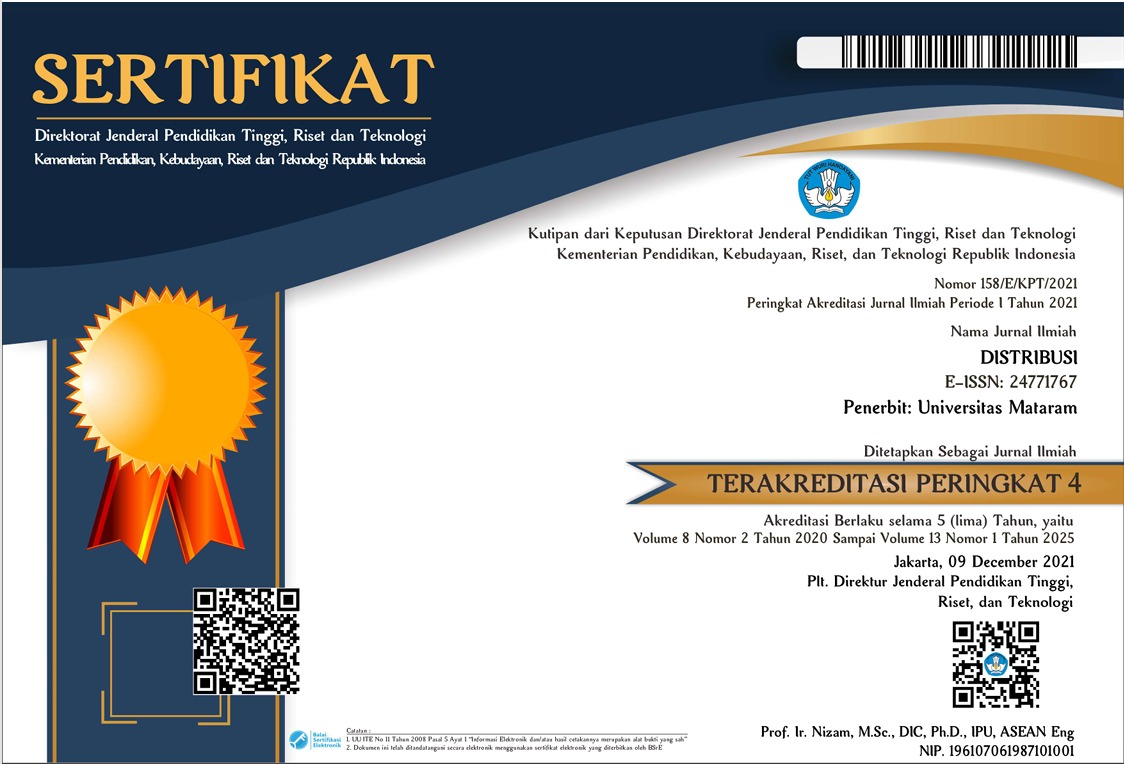STUDI KASUS GAP GENERASI DALAM PERSPEKTIF NILAI PERSONAL DAN BUDAYA ORGANISASI PADA PT. JASA RAHARJA (PERSERO) CABANG BALI
DOI:
https://doi.org/10.29303/distribusi.v10i1.242Keywords:
generation gap, personal values, organizational culture, Rokeach values, jasa raharjaAbstract
This study aims to explore the phenomenon of the generation gap that occurs at PT. Jasa Raharja (Persero) Bali Branch from the perspective of personal values and organizational culture. The multiple-case study method was used to do this. Data were collected through a survey using instruments from the Rokeach Value Survey for personal values and the Organizational Culture Assessment Instrument (OCAI) for organizational culture. A total of 47 respondents involved are employees of PT. Jasa Raharja (Persero) Bali Branch. The results obtained indicate that there is no generation gap, because both generations X, Y, and Z have the same terminal and instrumental values. The organizational culture that is felt today and which is expected in the future also shows the same type, namely clan, and market culture.
Downloads
References
Allport, G. W. (1977). Study of values: A scale for measuring the dominant interests in personality. Houghton Mifflin.
Andrianu, A. B. (2020). Resilient organizational culture: Cluj-Napoca case study. Eastern Journal of European Studies, 11(1), 335–357.
Bannon, S., Ford, K., & Meltzer, L. (2011). Understanding Millennials in the Workplace. The CPA Journal, 81(11), 61–65.
Barney, J. (1991). Firm Resources and Sustained Competitive Advantage. Journal of Management, 17(1), 99–120. https://doi.org/10.1177/014920639101700108
Bochert, R., Cismaru, L., & Foris, D. (2017). Connecting the Members of Generation Y to Destination Brands: A Case Study of the CUBIS Project. Sustainability, 9(7), 1197. https://doi.org/10.3390/su9071197
Cameron, K. S., & Quinn, R. E. (2011). Diagnosis and Changing Organizational Culture Based on the Competing Values Framework (3rd ed.). John Wiley & Sons, Inc.
Cascio, W. F. (2003). Changes in Workers, Work, and Organizations. In Handbook of Psychology. John Wiley & Sons, Inc. https://doi.org/10.1002/0471264385.wei1216
Del Giudice, M., Khan, Z., De Silva, M., Scuotto, V., Caputo, F., & Carayannis, E. (2017). The microlevel actions undertaken by owner-managers in improving the sustainability practices of cultural and creative small and medium enterprises: A United Kingdom-Italy comparison. Journal of Organizational Behavior, 38(9), 1396–1414. https://doi.org/10.1002/job.2237
Dulebohn, J. H., Bommer, W. H., Liden, R. C., Brouer, R. L., & Ferris, G. R. (2012). A Meta-Analysis of Antecedents and Consequences of Leader-Member Exchange. Journal of Management, 38(6), 1715–1759. https://doi.org/10.1177/0149206311415280
Fàbregues, S., Paré, M.-H., & Meneses, J. (2019). Operationalizing and Conceptualizing Quality in Mixed Methods Research: A Multiple Case Study of the Disciplines of Education, Nursing, Psychology, and Sociology. Journal of Mixed Methods Research, 13(4), 424–445. https://doi.org/10.1177/1558689817751774
Farcane, Deliu, & Bureană. (2019). A Corporate Case Study: The Application of Rokeach’s Value System to Corporate Social Responsibility (CSR). Sustainability, 11(23), 6612. https://doi.org/10.3390/su11236612
Feather, N. T. (1985). Attitudes, values, and attributions: Explanations of unemployment. Journal of Personality and Social Psychology, 48(4), 876–889. https://doi.org/10.1037/0022-3514.48.4.876
Festing, M., & Schäfer, L. (2014). Generational challenges to talent management: A framework for talent retention based on the psychological-contract perspective. Journal of World Business, 49(2), 262–271. https://doi.org/10.1016/j.jwb.2013.11.010
Finegan, J. E. (2000). The impact of person and organizational values on organizational commitment. Journal of Occupational and Organizational Psychology, 73(2), 149–169. https://doi.org/10.1348/096317900166958
Flippin, C. S. (2017). Millennials in the Workplace: Helping the Largest Generation Group Succeed at Work and in Their Careers (Kindle (ed.)). Candace Steele Flippin.
Granikov, V., Bouthillier, F., & Pluye, P. (2020). Understanding collaboration in monitoring research publications: Protocol for a qualitative multiple case study. Education for Information, 36(1), 69–79. https://doi.org/10.3233/EFI-190340
Josef Gellert, F., & Schalk, R. (2011). The influence of age on perceptions of relationship quality and performance in care service work teams. Employee Relations, 34(1), 44–60. https://doi.org/10.1108/01425451211183255
Kaur, S., Gupta, S., Singh, S. K., & Perano, M. (2019). Organizational ambidexterity through global strategic partnerships: A cognitive computing perspective. Technological Forecasting and Social Change, 145, 43–54. https://doi.org/10.1016/j.techfore.2019.04.027
Kluckhohn, C. (1951). VALUES AND VALUE-ORIENTATIONS IN THE THEORY OF ACTION: AN EXPLORATION IN DEFINITION AND CLASSIFICATION. In Toward a General Theory of Action (pp. 388–433). Harvard University Press. https://doi.org/10.4159/harvard.9780674863507.c8
Latham, G. P., & Pinder, C. C. (2005). Work Motivation Theory and Research at the Dawn of the Twenty-First Century. Annual Review of Psychology, 56(1), 485–516. https://doi.org/10.1146/annurev.psych.55.090902.142105
Lub, X., Nije Bijvank, M., Matthijs Bal, P., Blomme, R., & Schalk, R. (2012). Different or alike? International Journal of Contemporary Hospitality Management, 24(4), 553–573. https://doi.org/10.1108/09596111211226824
Lyons, S. T., Higgins, C. A., & Duxbury, L. (2009). Work values: Development of a new three-dimensional structure based on confirmatory smallest space analysis. Journal of Organizational Behavior, n/a-n/a. https://doi.org/10.1002/job.658
Mahmoud, A. B., Fuxman, L., Mohr, I., Reisel, W. D., & Grigoriou, N. (2021). “ We aren’t your reincarnation! ” workplace motivation across X, Y and Z generations. International Journal of Manpower, 42(1), 193–209. https://doi.org/10.1108/IJM-09-2019-0448
Mahmoud, A. B., Reisel, W. D., Fuxman, L., & Mohr, I. (2021). A motivational standpoint of job insecurity effects on organizational citizenship behaviors: A generational study. Scandinavian Journal of Psychology, 62(2), 267–275. https://doi.org/10.1111/sjop.12689
Mahmoud, A. B., Reisel, W. D., Grigoriou, N., Fuxman, L., & Mohr, I. (2020). The reincarnation of work motivation: Millennials vs older generations. International Sociology, 35(4), 393–414. https://doi.org/10.1177/0268580920912970
Mueller, D. J. (1974). A Test of the Validity of Two Scales on Rokeach’s Value Survey. The Journal of Social Psychology, 94(2), 289–290. https://doi.org/10.1080/00224545.1974.9923217
Papa, A., Dezi, L., Gregori, G. L., Mueller, J., & Miglietta, N. (2018). Improving innovation performance through knowledge acquisition: the moderating role of employee retention and human resource management practices. Journal of Knowledge Management, 24(3), 589–605. https://doi.org/10.1108/JKM-09-2017-0391
Parry, E., & Urwin, P. (2011). Generational Differences in Work Values: A Review of Theory and Evidence. International Journal of Management Reviews, 13(1), 79–96. https://doi.org/10.1111/j.1468-2370.2010.00285.x
Rokeach, M. (1974). Change and Stability in American Value Systems, 1968-1971. Public Opinion Quarterly, 38(2), 222. https://doi.org/10.1086/268153
Rokeach, M., & Cochkane, R. (1972). Self-Confrontation and Confrontation With Another as Determinants of Long-Term Value Change1. Journal of Applied Social Psychology, 2(4), 283–292. https://doi.org/10.1111/j.1559-1816.1972.tb01280.x
Rudolph, C. W., & Zacher, H. (2015). Intergenerational perceptions and conflicts in multi-age and multigenerational work environments. In Facing the challenges of a multi-age workforce: A use-inspired approach. (pp. 253–282). Routledge/Taylor & Francis Group.
Sarros, J. C., Gray, J., Densten, I. L., & Cooper, B. (2005). The Organizational Culture Profile Revisited and Revised: An Australian Perspective. Australian Journal of Management, 30(1), 159–182. https://doi.org/10.1177/031289620503000109
Schein, E. H., & Schein, P. A. (2016). Organizational Culture and Leadership (5th ed.). Jossey-Bass.
Schwartz, S. H. (1994). Are There Universal Aspects in the Structure and Contents of Human Values? Journal of Social Issues, 50(4), 19–45. https://doi.org/10.1111/j.1540-4560.1994.tb01196.x
Seemiller, C., & Grace, M. (2019). Generation Z: A century in the making. Routledge.
Srisuphaolarn, P., & Assarut, N. (2019). Winning CSR strategies for the talent war. Social Responsibility Journal, 15(3), 365–378. https://doi.org/10.1108/SRJ-06-2017-0107
Strauss, W., & Howe, N. (1992). Generations: The History of America’s Future, 1584 to 2069. HarperCollins Publishers.
Strauss, W., & Howe, N. (2009). The Fourth Turning: What the Cycles of History Tell Us about America’s Next Rendezvous with Destiny. Three Rivers Press.
Talmon, G. A. (2019). Generation Z: What’s Next? Medical Science Educator, 29(S1), 9–11. https://doi.org/10.1007/s40670-019-00796-0
Titov, E. (2015). Management paradigm values in real and propagated level as prerequisites of organisational success. Tallinn University of Technology.
Tsui, A. S., Egan, T. D., & III, C. A. O. (1992). Being Different: Relational Demography and Organizational Attachment. Administrative Science Quarterly, 37(4), 549. https://doi.org/10.2307/2393472
Tuulik, K., Õunapuu, T., Kuimet, K., & Titov, E. (2016). Rokeach’s instrumental and terminal values as descriptors of modern organisation values. International Journal of Organizational Leadership, 5(2), 151–161. https://doi.org/10.33844/ijol.2016.60252
Waltz, L. A., Muñoz, L., Weber Johnson, H., & Rodriguez, T. (2020). Exploring job satisfaction and workplace engagement in millennial nurses. Journal of Nursing Management, 28(3), 673–681. https://doi.org/10.1111/jonm.12981
Wey Smola, K., & Sutton, C. D. (2002). Generational differences: revisiting generational work values for the new millennium. Journal of Organizational Behavior, 23(4), 363–382. https://doi.org/10.1002/job.147
Woodward, I. C., Vongswasdi, P., & More, E. A. (2015). Generational Diversity at Work: A Systematic Review of the Research. SSRN Electronic Journal. https://doi.org/10.2139/ssrn.2630650
Zemke, R., Raines, C., & Filipczak, B. (1999). Generations at work: managing the clash of veterans, boomers, xers, and nexters in your workplace. Amacom Press.
Zenger, T. R., & Lawrence, B. S. (1989). ORGANIZATIONAL DEMOGRAPHY: THE DIFFERENTIAL EFFECTS OF AGE AND TENURE DISTRIBUTIONS ON TECHNICAL COMMUNICATION. Academy of Management Journal, 32(2), 353–376. https://doi.org/10.2307/256366
Downloads
Published
How to Cite
Issue
Section
License
Copyright (c) 2022 Yanuar Fauzuddin, Mochammad Syaiful Arif, Dwi Sasono, Hendrik Rizqiawan, Andi Iswoyo

This work is licensed under a Creative Commons Attribution-ShareAlike 4.0 International License.
Penulis yang naskahnya diterbitkan menyetujui ketentuan sebagai berikut:
- Hak publikasi atas semua materi naskah jurnal yang diterbitkan/dipublikasikan dalam situs Jurnal DISTRIBUSI ini dipegang oleh dewan redaksi dengan sepengetahuan penulis (hak moral tetap milik penulis naskah).
- Ketentuan legal formal untuk akses artikel digital jurnal elektronik ini tunduk pada ketentuan lisensi Creative Commons Attribution-ShareAlike (CC BY-SA), yang berarti Jurnal DISTRIBUSI berhak menyimpan, mengalih media/format-kan, mengelola dalam bentuk pangkalan data (database), merawat, dan mempublikasikan artikel tanpa meminta izin dari Penulis selama tetap mencantumkan nama Penulis sebagai pemilik Hak Cipta.
- Naskah yang diterbitkan/dipublikasikan secara cetak dan elektronik bersifat open access untuk tujuan pendidikan, penelitian, dan perpustakaan. Selain tujuan tersebut, dewan redaksi tidak bertanggung jawab atas pelanggaran terhadap hukum hak cipta.









